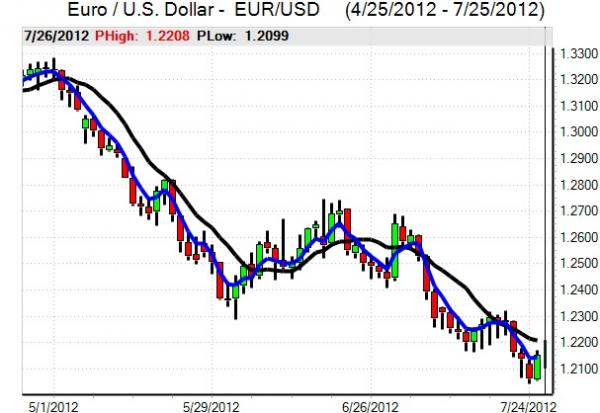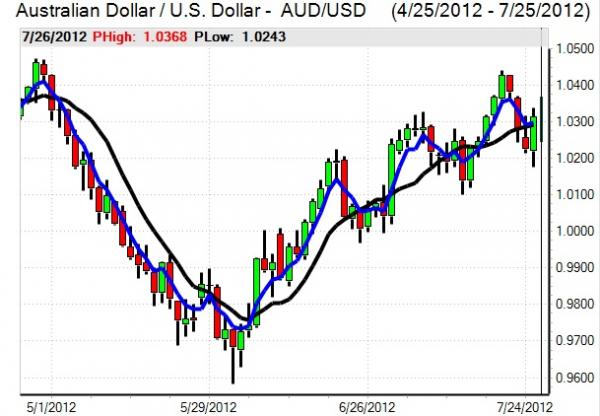EUR/USD
The Euro pushed higher during the European morning on Wednesday as it corrected stronger after finding support just above the previous day’s lows below 1.2050.
Spanish officials initially denied that the country was on the point of requesting a sovereign bailout and these comments were later repeated by a German Finance Ministry spokesman. The comments helped alleviate the immediate sense of panic surrounding Spanish markets as bond yields declined from record highs above 7.7%.
There were also comments from ECB member Nowotny who suggested the possibility of accelerated moves to granting the ESM a banking licence. Such a move would allow the ESM to buy government bonds in the secondary market and ease market pressures, but there was still a high degree of scepticism surrounding the comments which were presented as a personal view.
As far as the economic data is concerned, there was a third successive decline in the German IFO index to 103.3 for July from 105.2 previously as conditions continued to deteriorate, although this was not an extremely low figure in an historic context.
The US data was weaker than expected with new home sales declining 8.4% to an annual rate of 350,000 in the latest month which maintained unease over the US outlook, especially as housing had been a relatively firm sector over the past few months.
There was a decline in commodity prices and equity markets were subjected to renewed selling pressure which triggered some defensive dollar demand, but consolidation was the main theme with the Euro trading around the 1.2150 resistance area with no major change in Asian trading on Thursday. Underlying confidence remained fragile with 17 German banking groups put on a negative ratings watch by Moody’s.

Source: VantagePoint Intermarket Analysis Software
Call now and you will be provided with FREE recent forecasts
that are up to 86% accurate* 800-732-5407
If you would rather have the recent forecasts sent to you, please go here
Yen
The dollar found support in the 78 area against the yen on Wednesday while rallies quickly stalled in the 78.30 area after a brief surge following a media report that Japan was moving closer to intervention.
Deputy Bank of Japan Governor Yamaguchi warned that there would be a further policy easing if yen strength threatened the recovery. The Chinese yuan continued to edge weaker as it hit a 2012 low against the US currency. A weaker Chinese currency would increase competitiveness issues and also intensify pressure for yen gains to be resisted.
The CSPI index dipped 0.3% decline in the year to June, maintaining unease surrounding the threat of deflation, although the impact was limited and the dollar consolidated just above the 78 level.
Sterling
Sterling briefly pushed to the 1.5550 area against the US dollar on Wednesday with some anticipation that the economic data would be better than expected.
In the event, the latest GDP release was much weaker than expected with a reported 0.7% decline for the flash second-quarter estimate. This was the third successive quarterly contraction with the economy undermined by a further sharp decline in the construction sector as industrial output also weakened for the latest three months. There was some recovery in the latest services-sector output with a 0.5% gain in the three months to May.
The weak data will undermine confidence and lead to speculation over further Bank of England easing measures, potentially including an interest rate cut. There will also be increased fears that the UK AAA rating will be cut which would undermine the potential for capital inflows. There will also be additional political stresses with the Chancellor in particular under intense pressure.
Sterling rallies were blocked just above the 1.55 level before a retreat back to below this level in Asia on Thursday.
Swiss franc
The dollar was unable to hold above 0.9950 against the franc on Wednesday and retreated to test support in the 0.9870 area following a general corrective retreat with the Euro still trapped close to the 1.2010 level.
National Bank Chairman Jordan reiterated the determination to maintain the 1.20 minimum Euro level and also stated that it was theoretically possible for currency reserves to rise without limit. Markets will, however, be less confident that the bank’s nerve will hold if there is an intensification in capital flows from the Euro area and speculation over a policy shift will continue.

Source: VantagePoint Intermarket Analysis Software
Call now and you will be provided with FREE recent forecasts
that are up to 86% accurate* 800-732-5407
If you would rather have the recent forecasts sent to you, please go here
Australian dollar
The Australian dollar found below 1.0250 against the US currency on Wednesday and gradually climbed during the day with a peak close to 1.0340 as underlying risk appetite stabilised. There were also further expectations of defensive capital flows into the Australian currency as central banks looked to diversify reserves, especially with Euro confidence continuing to weaken.
There were no major initiatives during the Asian session on Thursday with the currency hitting resistance close to 1.0140.



